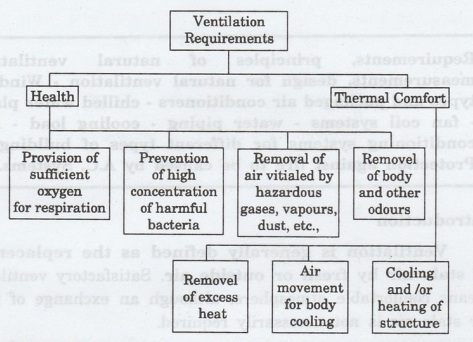Physics For Civil Engineering: Unit II: Ventilation And Refrigeration
Requirements and Types of Ventilation
The requirements of ventilation are shown in fig.
VENTILATION REQUIREMENTS
The requirements of ventilation are
shown in fig.

Health or permanent ventilation requirements
(a) Depletion of oxygen content -
The amount of fresh air required for respiration is small and although this
aspect cannot be neglected altogether, it can play only a very minor role in
the ventilation design of buildings.
(b) Bacteria concentration - One criterion
proposed for minimum ventilation standards is the elimination of the risk of
infection by air-borne micro-organisms.
(c) Removal of vitiated air - In the case of
the normal type of dwelling, contamination of air by hazardous gases such as
carbon monoxide from heating appliances is not likely to be significant because
such appliances are usually equipped with proper flues.
• The
removal of air polluted by noxious or hazardous gases, vapours, dust and other
contaminants produced by certain industrial processes generally requires
special attention.
(d) Removal of odours - minimum standard of
ventilation in spaces devoid of industrial contaminants seems to be the amount
of fresh air required to reduce the concentration of unpleasant body and other
odours to a level where they will no longer be objectionable.
All persons produce an of odour caused
by sweat, sebaceous secretion, and foul breath. The nature and amount of odour
given off varies from person to person since it is closely related to such
factors as race, diet and living pattern, and although it is generally not
harmful, odour may have an indirect effect on health by diminishing the
appetite.
Further, the presence of odours in a
room induces a feeling of stuffiness and discomfort. It is especially from a
fresh noticeable to people entering such a room atmosphere. to amurotibus 2911вort
290mto gid tot botqobs
Comfort or Occasional ventilation requirements
(a) Removal of excess heat- Since excess
heat liberated within occupied spaces combined with the net heat gain through
the various structural elements, particularly in summer, contributes
considerably to thermal discomfort, all excess heat should, as far as possible,
be removed by ventilation.
(b) Air movement for body cooling -
A part from the relatively high ventilation rates required for the removal of
heat dissipated within the space, high air movements is also desirable under
warm conditions for body cooling purposes.
(c) Ventilation for cooling or heating of structure -
Another important purpose of ventilation that is closely related to comfort is
the utilization of air flow during periods of low or high air temperature to
cool or heat the structure and its contents. This can be achieved, particularly
in more massive structures in warm
climates
Types Of Ventilation
The system of ventilation is classified
into two types
1.
Natural ventilation
2.
Mechanical or artificial ventilation
Physics For Civil Engineering: Unit II: Ventilation And Refrigeration : Tag: : - Requirements and Types of Ventilation
Related Topics
Related Subjects
Physics for Civil Engineering
PH3201 2021 Regulation | 2nd Semester Civil Dept 2021 Regulation
